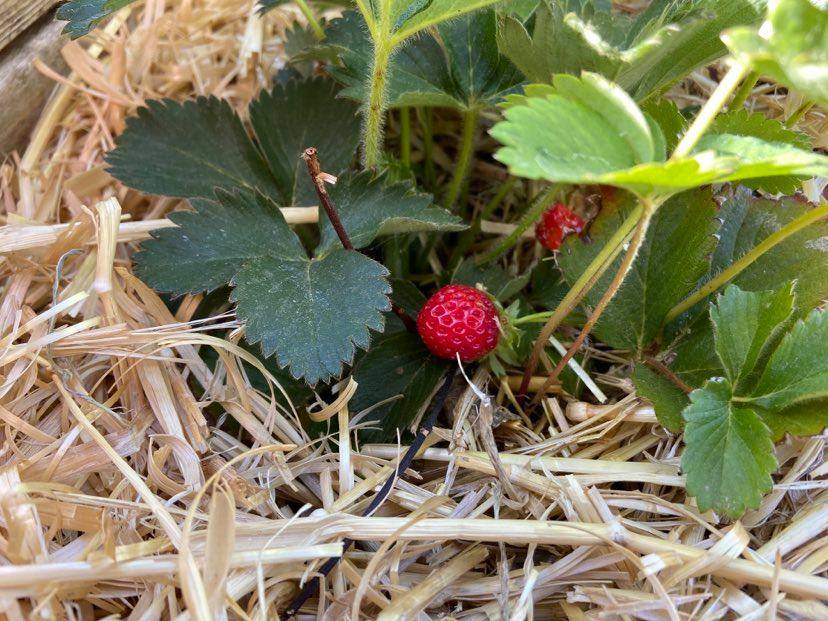In Season: Strawberries are not just for northern climates
If you hail from a cooler, northern climate, you may have nostalgic memories of picking fresh wild strawberries in the spring and summer. The red juices flowing down your chin feel like a bit of heaven. Perhaps this is why I’ve received many questions lately about strawberries. Chief among them, can they be grown here?
I’m excited to tell you that the answer to that question is yes! I’ve been harvesting strawberries from my garden for well over a month now. Strawberries grow quite well in our climate with the proper care and conditions. It all begins with choosing the right varieties.
Strawberry varieties for Pahrump:
Before you head out to the nursery to purchase strawberry starts, there are a few things to keep in mind. Strawberries are a perennial and will continue to produce year after year. They put off runners that create more strawberry plants. Due to this, strawberries need to be divided at least every three years to prevent overcrowding.
There are two types of strawberries that you can usually find: day-neutral, which will produce fruit spring through fall; and short-day, which will produce most of its fruit at the onset of summer before the triple digits hit.
For our climate, I suggest sticking with day-neutral varieties, which are also often labeled as everbearing. Once your strawberry bed is established and thriving you may be able to harvest nearly all year except through the worst of the summer heat.
Of the day-neutral varieties I have two favorites that do very well in my garden. The first is called “Pretty in Pink.” The berries it produces are small to medium size and fairly sweet. What I love most about it is the pretty pink flowers that really make it stand out in the garden.
The second variety is called “Sequoia.” Sequoia produces larger berries than Pretty in Pink but not as large as you might find in northern climates. No matter which variety you choose to plant, when picked at the peak of ripeness, the berries are more flavorful than anything you can buy in the grocery store.
Planting and caring for strawberries:
In our climate, the best time of year to plant them is in the fall, usually around mid- to late October. Choose a spot that receives at least 6 to 8 hours of sun and afternoon shade during the summer.
Before planting, amend the soil with compost or well-rotted manure. Make small hills 6 inches in circumference and 6 inches high and at least 1 foot apart. Spread the roots out evenly over the hill. Cover the roots with more soil and firmly push the soil down while maintaining the shape of the hill. Be careful to plant the roots and not the crowns of the plant. Give the newly planted strawberries a gentle soaking and then mulch around the base of the plants.
Water strawberries frequently, especially in the summer. In my garden, they are on the same drip system as the rest of the vegetables I grow.
The dripper is set to automatically turn on twice a day for 10 minutes when it is less than 90 degrees and three times a day for 10 minutes when it is over 90 degrees. When temperatures drop below 80 degrees, I water three times a week for 10 minutes.
Strawberries should be fed again when they begin to blossom. I like to use compost tea that I make from my compost and chicken manure or worm casings. I’ve recently acquired a rescue duck and use the water from his pool to fertilize my garden.
The first year after you plant your strawberries, it is recommended that you pinch the blossoms instead of letting them form into fruit for better production and larger berries in future years. I do not follow this advice myself, though, as I do not mind small berries.
The most common pest issue that you might encounter with growing strawberries is that birds love them as much as we do. To combat this, you can try bird netting. Rather than covering the plant directly with the netting, I suggest creating a structure with PVC piping by bending it in arcs over the strawberry bed and tying your netting to that, similar to the appearance of a covered wagon. The PVC can be slipped over rebar pounded into the ground to create support for the structure.
Another way to keep the berries away from the birds is to harvest them just before they turn deep red and let them finish ripening on your counter. They should be at their sweetest in a day or two. To harvest strawberries, cut them at the stem where they meet the plant.
When winter arrives, watch the weather report for freeze warnings. If a freeze is coming, cover your strawberry plants with an old sheet or some burlap during the night. The cover should be removed during the day. If you forget or miss this step your strawberries may die back but most likely you will see new growth once temperatures warm.
Though strawberries require a bit more work than some other perennials you might grow, they are well worth the effort—even if only to relive for a few brief moments those cherished childhood memories and perhaps even share them with children of your own.
Terri Meehan is the Founder of Southern Nevada Gardening Association a regional group. She is a garden mentor and local farmer in Pahrump. Send questions or comments to her at sonvgarden@gmail.com

















